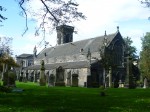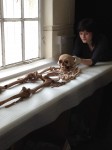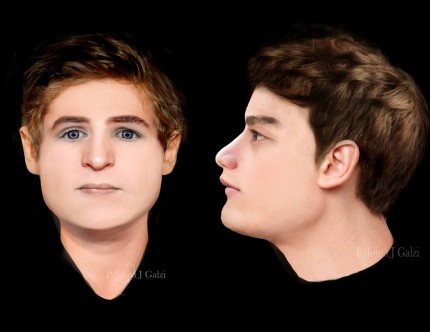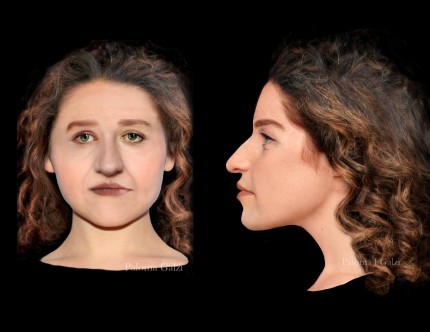 In 2009, preparatory work for the Edinburgh Trams project unearthed approximately 400 medieval and early modern burials under Constitution Street. The site had once been part of the South Leith Parish Church graveyard in the port town of Leith (incorporated into Edinburgh in 1920) but had fallen into disuse centuries earlier and was quickly forgotten. In 1790 the Church Council declared they knew of no bodies buried in that location when Constitution Street was built to provide better access to the harbor. The archaeological survey was done because the Constitution Street area was close to the city center of early medieval Leith and to the town’s defenses in the 16th and 17th centuries. The discovery of so many human remains outside the wall of the existing graveyard, therefore, was an unexpected and potentially important source of information about how people lived in died in medieval Leith.
In 2009, preparatory work for the Edinburgh Trams project unearthed approximately 400 medieval and early modern burials under Constitution Street. The site had once been part of the South Leith Parish Church graveyard in the port town of Leith (incorporated into Edinburgh in 1920) but had fallen into disuse centuries earlier and was quickly forgotten. In 1790 the Church Council declared they knew of no bodies buried in that location when Constitution Street was built to provide better access to the harbor. The archaeological survey was done because the Constitution Street area was close to the city center of early medieval Leith and to the town’s defenses in the 16th and 17th centuries. The discovery of so many human remains outside the wall of the existing graveyard, therefore, was an unexpected and potentially important source of information about how people lived in died in medieval Leith.
A comprehensive study of the bones ensued, complete with forensic examinations, isotope analysis and facial reconstructions of all the bodies where there were sufficient remains to make it possible. In the final tally, there were 302 complete burials with partial remains of at least 100 more people discovered. Thirty-three of the bodies were dated. They all pre-date 1640 with the earliest dating to 1315. The South Leith Parish Church was founded as St Mary’s Chapel almost two centuries later in 1483, and 33% of the burials happened before that date, which means this church was built on the site of a pre-existing one.
 The 1640 cut-off may be related to the Plague of 1645 which killed 2,700 people, half the population of Leith. The South Leith Parish Church played an important role in implementing sanitary measures and in the care of the sick during the plague, but its graveyard couldn’t handle the burial of half the city nor would the center of town be an ideal location for large plague pits. Then the Civil War happened. The church was occupied and used as a powder magazine by Parliamentary troops from 1650 until 1657. It was subsequently restored to ecclesiastical use, but the one-two punch of plague and war may explain why the burials stopped and were all but erased from memory.
The 1640 cut-off may be related to the Plague of 1645 which killed 2,700 people, half the population of Leith. The South Leith Parish Church played an important role in implementing sanitary measures and in the care of the sick during the plague, but its graveyard couldn’t handle the burial of half the city nor would the center of town be an ideal location for large plague pits. Then the Civil War happened. The church was occupied and used as a powder magazine by Parliamentary troops from 1650 until 1657. It was subsequently restored to ecclesiastical use, but the one-two punch of plague and war may explain why the burials stopped and were all but erased from memory.
Researchers determined that the people buried in this part of the churchyard were shorter than the UK average of 164cm for women and 171cm for men. The average height of the women was 155cm (5’1″) while the men averaged 169cm (5’5.5″). The overwhelming majority (90%) died before the age of 35 and 32% of the deceased were children, particularly older children aged 7-12. Isotope analysis on the remains of 18 bodies found that 80% were very much local having been raised in the Leith/Edinburgh area. The rest were only slightly less local, having been raised within a radius of 15-30 miles.
Most were buried in single graves, interred in wooden coffins or wrapped in shrouds. Three communal graves were found in which women were buried with children. One woman was found buried with a neonate across her pelvis, which means she probably died late in her pregnancy or in childbirth.
 The facial reconstructions done by post-graduate students at the University of Dundee’s Forensic Art course personalize all these facts and figures.
The facial reconstructions done by post-graduate students at the University of Dundee’s Forensic Art course personalize all these facts and figures.
By using forensic modelling to determine the shape and depth of facial muscles and soft tissues, isotopic analysis to ascertain individuals’ origins and state-of-the-art computer programming, researchers were able to build up lifelike facial representations for the 400 to 600-year-old remains.
Amongst the reconstructions was that of a boy, aged between 13 and 17, who was thought to have lived around Leith and Edinburgh and to have died in the late 14th or early 15th century, an adult male aged 25 to 35 who lived in the mid 16th to 17th century and a woman also aged between 25 and 35, who died in the late 14th and early 15th century.


How totally brilliant!
Kudos to whoever thought of giving these remains to Forensic students for reconstruction. :notworthy: :notworthy: :notworthy: :notworthy: The students get to practice their skills and we get to see real people from another time.
To paraphrase a quote I once read elsewhere… the Scots are an extraordinarily pretty people.
“The Leith police dismisseth us.” Tongue-twister used as a sobriety test.
50% death rate? Good grief: forgotten because of the Civil Wars?
Hold on, it’s a port. How many of the dead were just passing through; or not, as the case may be?
From the article: “Isotope analysis on the remains of 18 bodies found that 80% were very much local having been raised in the Leith/Edinburgh area. The rest were only slightly less local, having been raised within a radius of 15-30 miles.”
Where a person has been raised, and lived, can be determined by chemical examination of their tooth enamel. Bones and hair also hold this data.
The enamel on our teeth holds the chemical blueprint of the foods we ate. In medieval times, when people seldom went more than 20 miles from their place of birth, it would have been very accurate.
The science is now so refined that it can detect a difference between people living on the east coast of Britain and eating seafood and people from the west coast with the same general sort of diet.
True, but the bodies studied all died before 1640, and the attack of plague was in 1645.
Presumably the South Leith Parish Church graveyard anyway contained predominantly the bodies of parishioners. I wonder where the bodies of outsiders were buried in normal times – I imagine that there would be a feeling that they must be given a Christian burial, wherever they came from.
It’s hours later and my head is still spinning with the thought that 50% died and that I’d never heard about it.
This is so cool is there a link for more on it? My paternal family was orignal from the Govan area.left for Ireland in the 1600’s then on to America in earyl 1700s. Altho they inter married with mostly other upper class families, some of these could be my relates. So I’d like to read more on them
This is so cool is there a link for more on it? My paternal family was orignal from the Govan area.Our side of the family left for Ireland in the 1600’s then on to America in early 1700s. Altho they inter married with mostly other upper class families, some of these could be my relates. So I’d like to read more on them.
You note that the South Leith Parish Church played an important role in implementing sanitary measures and in the care of the sick, but _nothing_ could stop the Black Death. If we are surprised that many of the bodies were wrapped in nothing but simple shrouds, I suppose the need to bury hundreds of people very rapidly would explain why proper coffins would have been impossible.
In times when there was no catastrophic plague, were bodies normally given individually inscribed tomb stones?
In times when there was no catastrophic plague, were bodies normally given individually inscribed tomb stones? Answer: yes!Depending on who you were .And probley how much cash you had to splash around. Iona has the tombstones of the kings of Scotland Govan Old Church,which isnt realy that old, it was rebuilt, has Tombstone dating back to the 1500s and also the hogback stones.There said to be tombstones from before the middle ages. Recently they dug up a Knight and his family in Scotland and his tombstone can be found here. http://news.discovery.com/history/archaeology/medieval-knight-grave-parking-lot-130315.htm quite pretty too. and altho it’s not much to look at theres this from Finlaggen castle http://finlaggan.com/page/39.asp so even children were being marked. I think many of the old stones just havent surrived. Also some such as at Govan old Church were reused by latter generations of the same family.
I took the reference to the bodies in the “lost” section of the graveyard being pre-1640 as meaning the 1645 plague and the subsequent war had a significant impact on cultural/institutional memory. The church was used as a stage for war, so not only was a large portion of the population (and their memories) lost, but it is likely that many records were as well. It is not surprising under the circumstances that an older section of the cemetary was simply forgotten. This happens even in more modern times, and is still happening in places where people’s lives are in upheaval from war, epidemics, and natural disasters. How many of us know anything of what happened to Native North American cultures after the arrival of Europeans in the same period? Native Americans are just now piecing together the remnants of their cultures and history. See how easy it is to lose track of things?